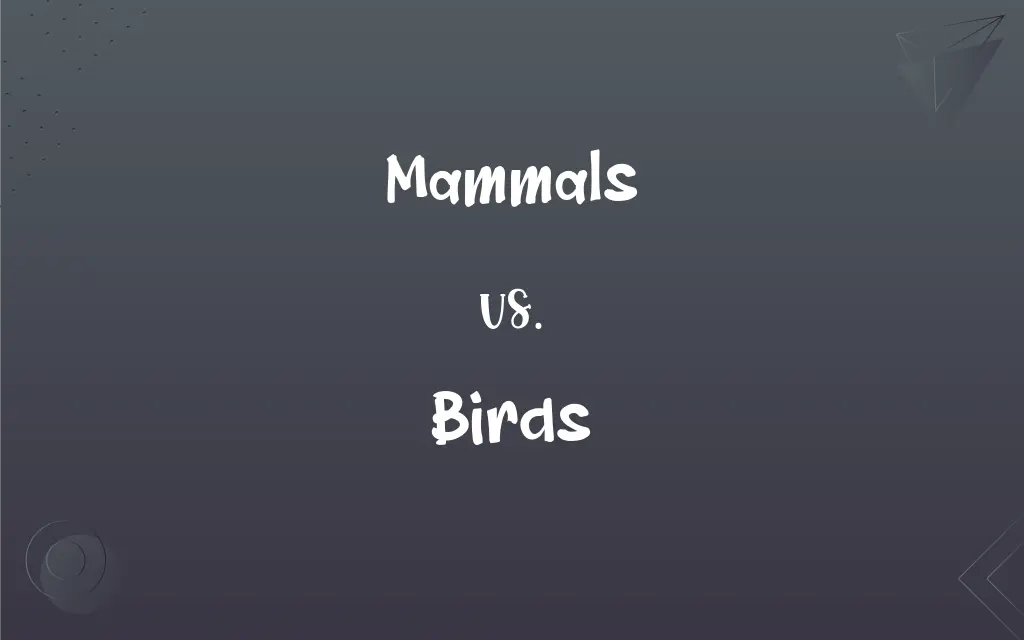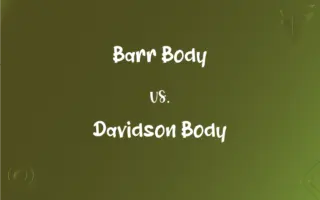Mammals vs. Birds: What's the Difference?
Edited by Aimie Carlson || By Janet White || Published on February 10, 2024
Mammals are warm-blooded vertebrates with hair/fur and mammary glands; birds are warm-blooded vertebrates with feathers and beaks.

Key Differences
Mammals are a class of warm-blooded vertebrates characterized by the presence of hair or fur, whereas birds, another class of warm-blooded vertebrates, are distinguished by their feathered bodies. Both groups are endothermic, but they exhibit these distinct outer coverings.
The reproductive system of mammals includes mammary glands, which produce milk to nourish their young. Birds, on the other hand, lay eggs with hard shells and do not possess mammary glands. This difference highlights a fundamental divergence in their reproductive strategies.
Mammals breathe through lungs throughout their entire lives, and this is also true for birds. However, birds have a unique respiratory system that includes air sacs, providing them with the efficient oxygen flow necessary for flight.
The skeletal structure of mammals includes a variety of bone arrangements, accommodating diverse lifestyles from burrowing to swimming. Birds have a lightweight, hollow-boned skeleton optimized for flight, with specific adaptations like fused bones and a keeled sternum for muscle attachment.
Mammals often have well-developed brains, supporting complex behaviors and learning. Birds also exhibit high intelligence, with some species demonstrating problem-solving skills and social complexity. Despite their different evolutionary paths, both groups have achieved notable levels of intelligence.
ADVERTISEMENT
Comparison Chart
Body Covering
Fur or hair
Feathers
Reproduction
Live birth (mostly)
Egg-laying
Breathing Organ
Lungs only
Lungs with air sacs
Skeleton
Varies widely
Lightweight, hollow bones
Intelligence
Generally higher
Varies, some very intelligent
ADVERTISEMENT
Mammals and Birds Definitions
Mammals
Mammals nourish their young with milk from mammary glands.
The mother kangaroo feeds her joey milk in her pouch.
Birds
Birds are warm-blooded vertebrates with feathers.
The robin, a small bird, fluffed up its feathers in the cold.
Mammals
Mammals are warm-blooded animals with fur or hair.
The cat, a common mammal, curled up on the windowsill.
Birds
Most birds are capable of flight, though some are flightless.
Penguins, although birds, are adapted for swimming instead of flying.
Mammals
Mammals are characterized by their three middle ear bones.
The intricate structure of the mammal's ear bones aids in its acute hearing ability.
Birds
Birds lay hard-shelled eggs.
In spring, many birds can be seen tending to their nests of eggs.
Mammals
Mammals have a four-chambered heart.
The mammal's four-chambered heart efficiently circulates blood throughout its body.
Birds
Birds have a high metabolic rate and a four-chambered heart.
The hummingbird's rapid heartbeat supports its high-energy lifestyle.
Mammals
Most mammals give birth to live young.
Elephants are known for their extended gestation period before giving birth to live calves.
Birds
Birds have beaks without teeth.
The parrot used its curved beak to crack open nuts.
Mammals
Any of various warm-blooded vertebrate animals of the class Mammalia, including humans, characterized by a covering of hair on the skin and, in the female, milk-producing mammary glands for nourishing the young.
Birds
Any of various warm-blooded egg-laying feathered vertebrates of the class Aves, having forelimbs modified to form wings.
Mammals
Plural of mammal
FAQs
Do all mammals give live birth?
Most do, but some, like the platypus, lay eggs.
What are the key features of birds?
Birds have feathers, lay eggs, and most have the ability to fly.
How do mammals regulate their body temperature?
Mammals are warm-blooded, maintaining their temperature internally.
How do birds care for their young?
Birds typically care for their young by feeding them regurgitated food.
Are birds warm-blooded?
Yes, birds are warm-blooded and maintain a high body temperature.
What defines a mammal?
Mammals are characterized by fur or hair, mammary glands, and typically live births.
Can birds be toothless?
Yes, all birds have beaks without teeth.
Do mammals have a specialized respiratory system?
Mammals have lungs, but not as specialized as the bird respiratory system.
How do birds breathe?
Birds breathe through lungs complemented by air sacs for efficient oxygen exchange.
What kind of heart do mammals have?
Mammals have a four-chambered heart.
Do all mammals have hair or fur?
Yes, all mammals have some hair or fur at some stage of life.
Are feathers unique to birds?
Yes, feathers are a defining characteristic of birds.
How do mammal young feed?
Mammal young typically feed on milk from their mothers.
Are there any flightless birds?
Yes, several bird species, like ostriches and kiwis, are flightless.
What type of heart do birds have?
Birds also have a four-chambered heart.
Can mammals be aquatic?
Yes, some mammals like whales and dolphins are fully aquatic.
Do any birds live in water?
Yes, some birds, like penguins, are adapted to aquatic lives.
What is the largest mammal?
The blue whale is the largest mammal.
What is the largest bird?
The ostrich is the largest bird by height and weight.
Are there flightless mammals?
Yes, many mammals like sloths and moles do not have the ability to fly.
About Author
Written by
Janet WhiteJanet White has been an esteemed writer and blogger for Difference Wiki. Holding a Master's degree in Science and Medical Journalism from the prestigious Boston University, she has consistently demonstrated her expertise and passion for her field. When she's not immersed in her work, Janet relishes her time exercising, delving into a good book, and cherishing moments with friends and family.
Edited by
Aimie CarlsonAimie Carlson, holding a master's degree in English literature, is a fervent English language enthusiast. She lends her writing talents to Difference Wiki, a prominent website that specializes in comparisons, offering readers insightful analyses that both captivate and inform.































































